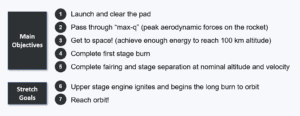Astra is on a mission to launch a new generation of space services to observe, connect and improve life on earth. Despite damage to our launch system this spring, the ongoing COVID-19 pandemic, and even an earthquake off the coast of Kodiak, Alaska, our team has been incredibly resilient and we are on track for a launch in the beginning of August.
Our approach to reaching orbit
Astra’s mantra is rapid iteration. Build, test, learn and repeat. We’re changing the way space is done by accepting slightly more risk in order to learn more quickly. We can afford to experiment because our rockets are far less expensive than the industry average. We aren’t afraid of failure; in fact, as long as we learn from it, failure is valuable and ultimately built into the plan.
It’s rare that a new launch vehicle accomplishes all of its objectives with its first flight, and the past few months in the launch industry have once again proven just how hard getting to space can be, even for mature vehicles. That said, we believe that we can achieve orbit within 3 flights, and our goal for Rocket 3.1 is to learn enough to set us on that path.
For this flight, our first orbital attempt, our primary objective is to achieve a nominal first stage burn. If we make it this far, we’ll be happy with our progress and be well on our way to reaching orbit within 3 flights. The more we accomplish, the more we learn, and the closer we are to reaching orbit.

With each new vehicle, we are iterating towards orbit. Even before we launch 3.1, Rocket 3.2 is nearly complete and Rocket 3.3 is close behind. No matter what happens with Rocket 3.1, we’ve ensured that we are set up to learn, improve, and return to the launch pad with a more capable vehicle as quickly as possible.
Launch details
Rocket 3.1 will launch from Astra’s Kodiak Launch Site (pad LP-3B at Pacific Spaceport Complex – Alaska (PSCA) on Kodiak Island). We are proud to partner with the team at PSCA and are grateful for their support.
Our launch window is from August 2-7, 7:00 – 9:00pm Pacific Time (PT) each day. We are aiming for August 2, subject to weather constraints and final launch preparations being completed.
This is a demonstration mission, and therefore Rocket 3.1 will not have a payload. We did not feel it was appropriate to risk a customer satellite for our first orbital launch attempt. That said, if Rocket 3.1 does make it to orbit, the vehicle will send an electronic signal that simulates the deployment of a satellite.
How to follow along
Our team has been focused on the engineering challenges of making it to orbit in the next 3 flights. We don’t have a marketing, communications, or video production team, so our ability to produce a public webcast is limited. Instead, we’ll be live-tweeting updates, so be sure to follow us @Astra.
After the launch, we look forward to sharing as much as we can with the public. Rocket 3.2 should only be a few months behind, so look forward to more launches in the near future!
Ad Astra Per Alaska!
Chris and Adam